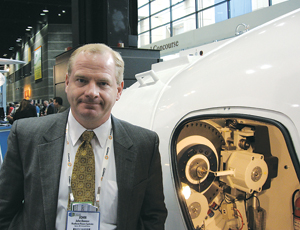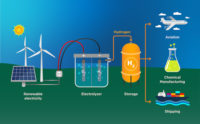Wind-power owners, developers and suppliers are preparing to soar under a new round of federal incentives. The news had 23,200 visitors—78% more than last year—blowing into the world’s largest conference on wind-generated electricity. On tap was February’s passage of the American Recovery and Reinvestment Act, which boosts production tax credits (PTCs) to reduce owners’ tax burden for the first 10 years of operation. Wind PTCs are extended two years, through Dec. 31, 2012. Developers also can claim an alternate investment tax credit (ITC) or Treasury Dept. grant to recoup 30% in the first year.

ITCs attempt to free up cash in a time of tight credit. “The value of the ITC or grant becomes more profitable than the PTC for wind projects with lower capacity costs or higher capital costs,” said Joshua Magee of Emerging Energy Research at WINDPOWER 2009, held May 4-7 in Chicago. As a result, President Obama’s ARRA package promises to increase wind-power installations after 2009, assuming that liquidity bounces back, Magee added.
Wind experts expect applications to begin arriving in July, and the first checks could come by September. Spending is expected to ramp up again next year because developers must begin outfitting projects by 2010 and complete them by 2012 to qualify for ITCs, says Washington, D.C.-based show owner and trade group American Wind Energy Association. But the Treasury has never before released cash grants to energy projects, so “bureaucratic red tape may delay enactment,” warned Magee’s firm in a May 1 report.
AWEA calculates total U.S. installed wind-power capacity of 25,369 MW in 2008. The number is expected to increase by 5,500 MW this year.
As the U.S. market bounces back, global companies will seek a larger chunk of the business. Germany-based Siemens, the third-largest domestic turbine supplier with 791 MW or 344 units installed last year, plans to open a 300,000-sq-ft plant in Hutchinson, Kan., in August. The factory will produce 650 nacelles per year for the company’s 2.3-MW-sized turbines. A nacelle is a cover housing that holds turbine generators.
Nordex, also of Germany, recently opened a U.S. office in Chicago and will begin manufacturing 2.5-MW turbines in Jonesboro, Ark., later this year. “We have an export ratio of 95%,” says Felix Losada, a spokesman for Nordex. “Our main markets are France, Italy, the U.K., China and the U.S. Our goal is to install 20% of our revenue in U.S. turbines.”
Spain-based developer Iberdrola Renewables, which claims to be the second-largest wind-power provider in the U.S. and global leader, plans to expand upon its base of 2,800 MW of U.S. turbines. They represent about 30% of its global renewable output. It spent $2.2 billion last year in the U.S. on new wind developments compared to $1.5 billion in 2007.
Other countries are expanding at a brisk pace. Scotland has the largest turbines in the world, at 5 MW, located off the Aberdeen coast, and offshore turbines as large as 10 MW are in development for the U.K. region.
In the U.S., the bulk of wind power is still on land, but turbine technology is advancing from the inside out. In Alaska, Northern Power Systems, Barre, Vt., has supplied 15 small, direct-drive turbines built to withstand Arctic cold. Over the past 10 years, the wound-rotor generators proved to be a low-cost alternative to diesel generators. But at the wind conference, Northern premiered its next-generation turbine, the Northwind 100, for schools, farms and small businesses. The 100-kW, commercial unit has a generator and rotor that are directly coupled by means of an innovative, permanent-magnet generator, passively cooled by wind.
One industry veteran was so surprised at the simple design that he remarked to Northern CEO John Danner, “Why didn’t you bring a completed turbine to the show?” Typically, gearboxes must be replaced three to four times over 20 years; instead of 52 bearings that can fail, it has two bearings and no hydraulics. “Our turbine has lower maintenance costs, higher availability, better power capture and reduced drivetrain noise,” said Danner. He now is developing a 2.2-MW utility turbine, due out next year, that may make wind-farm maintenance a breeze.



Post a comment to this article
Report Abusive Comment